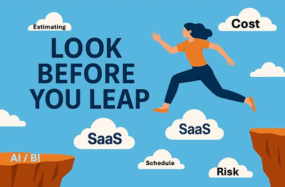
The Software Vendor Lock-In Trap: Why Your Cloud Should Stay Independent

Cloud Promised Freedom
Cloud adoption surged because it promised agility, scalability, and faster delivery. For IT leaders, it looked like the end of hardware sprawl and endless procurement cycles. Teams could scale resources on demand and launch new initiatives without waiting months for capital approval.
Cloud application hosting services gave organizations flexibility they had never experienced before. Instead of investing in fixed infrastructure, they could pay for only what they used.
But that freedom has quietly narrowed. Independent Software Vendor (ISV) clouds and hyperscalers increasingly control the roadmap, dictate upgrade cycles, and structure pricing to make exit costly. What began as IT leaders directing their own strategies has shifted toward vendors setting the terms — leaving many organizations with less control than they had before.
The Drift Toward Dependence
The shift from freedom to dependence didn’t happen all at once. It crept in slowly, as vendors found ways to tighten their grip on customers.
Vendor clouds expanded beyond their core offerings by bundling proprietary modules together. What looked like convenience at first soon meant organizations had to buy into an entire ecosystem, even if only one piece was needed. Roadmaps became rigid, with release cycles dictated by the vendor, not the business.
Meanwhile, hyperscalers made it easy to spin up workloads but hard to move them later. Proprietary APIs became the glue that tied applications to a single cloud. Data egress fees added friction to every attempt at portability. Over time, the very platforms meant to deliver flexibility began to constrain it.
Most IT leaders didn’t see it happening. Adoption felt like progress, but each new dependency reduced room to maneuver. By the time the warning signs became clear — escalating renewals, workloads too integrated to move, or strategic roadmaps dictated externally — the organization was already caught in a pattern of vendor-driven control.
This slow drift is what makes vendor lock-in so powerful. In the next section, we’ll look at its two most common forms — and why both lead to the same result: loss of control.
The Trap – Two Faces of Vendor Lock-In
Vendor lock-in shows up in different ways, but the outcome is always the same: IT leaders lose control over cost, strategy, and innovation.
- Vendor cloud lock-in. License bundles expand beyond what you need. Vendors dictate release cycles, leaving internal plans disrupted. And because data stays siloed inside each application, integration and analytics remain limited. (This makes transforming to a future product extremely difficult when all they offer you is a flat file export of your data.)
- Hyperscaler lock-in. Workloads become dependent on proprietary services and APIs. Data egress fees make portability expensive. Pricing structures reward staying put and punish diversification.
The mechanisms differ, but the result is identical: control shifts from IT to vendors. When control slips, innovation slows. With applications and data stuck in silos, teams can’t align information across the enterprise — blocking the synchronization needed for AI, predictive analytics, and automation at scale.
And even when organizations spread workloads across on-prem, vendor clouds, and public cloud, with hybrid cloud solutions, the problem doesn’t disappear. Without governance, that mix becomes another form of lock-in — more complex, but just as limiting.
The False Escape – Hybrid Cloud Without Control
Most enterprises already run hybrid cloud—81% today, trending toward 90% by 2027 (Gartner). In many cases, it wasn’t a top-down decision. It accumulated over time: a legacy system stays on-prem, vendor clouds expand by department, and public-cloud workloads get added for speed.
The result is a mixed estate that behaves like a patchwork. Data is fragmented across environments, integrations are brittle, and policies are applied inconsistently. Rather than creating freedom, hybrid often multiplies operational complexity and introduces a different form of dependence—harder to see, but just as limiting.
Many “cloud data platforms” help centralize storage or analytics, but stop short of unifying applications, governance, and data movement across the whole estate. That leaves teams with cloud-based silos and slows the work needed for AI and automation. Some IT leaders have tried to claw back control with tools like Azure Conditional Access in Microsoft environments or AWS IAM policies in Amazon’s. Both approaches can enforce governance inside a single cloud, but they don’t solve the cross-platform inconsistencies that define hybrid estates.
What’s missing is control: consistent governance, portable workloads, and a unified data foundation across environments. That’s the shift we take up next.
The Case for Independence
Independence means running the right workload in the right environment—without being tied to a vendor’s roadmap. It’s a posture, not a place: standards-first design, portable data, and contracts you can exit or renegotiate on your terms.
For IT directors, independence delivers:
- Flexibility in workload placement. Match compute, storage, and services to each use case, and move or refactor when requirements change—without rewriting around proprietary APIs.
- Cost control. Avoid pricing games by architecting for portability, limiting egress exposure, right-sizing licenses from real usage, and negotiating renewals from a position of choice.
- Resilience. Adjust quickly to regulatory, cyber, or supplier risk—support data residency, multi-region failover, and vendor diversification without re-platforming.
- Innovation. Adopt new AI/ML tooling and data services on your timeline; a clean, governed data layer turns pilots into scalable capabilities.
Use these as evaluation criteria. Whatever you adopt should preserve workload portability, keep data consistent and interoperable, and enforce policy centrally. If it doesn’t protect those basics, it erodes independence.
The Way Forward – Unified Cloud Platforms
So what’s an IT leader to do? If independence is the goal, you need a way to run across vendor clouds, on-prem, and public clouds without ceding control. The pragmatic answer is a unified cloud platform [link to UPP pillar content]: a vendor-neutral control layer that standardizes how your organization accesses, secures, operates, and measures applications and data across environments, rather than tying those decisions to any one provider.
It integrates applications, data, and AI across on-prem, vendor clouds, and public clouds—while keeping workloads and information portable—so you’re not locked to any one provider.
What it is. UPP isn’t a hosting destination or middleware patch; it’s a new category where users, applications, data, and intelligence converge to deliver adoption, security, and real-time insight. At its core, it:
- Integrates project applications (no matter where they run) with a consistent “single pane of glass” for launch, management, and administration.
- Transforms and unifies data into a common structure so decisions aren’t delayed by manual reconciliation or stale warehouses. Gartner estimates that poor data quality costs organizations an average of $12.9 million annually, a penalty that only grows when data is fragmented across multiple environments.
- Enables AI interrogation—everyone can ask natural-language questions and get near real-time, context-rich answers drawn from the unified dataset.
- Centralizes identity, access, and governance so policy is enforced uniformly across the estate.
- Operates as an ecosystem so internal teams and external partners work from the same version of truth.
For IT directors, this shows up as a true single pane of glass software experience—not just dashboards but real-time visibility into application performance, license utilization, and integration health, paired with operational control.
Why this is the way forward (mapped to the problems above)
- Eliminates silos by unifying applications and data. One secure entry point and a consolidated operational view replace scattered access points and fragmented reporting.
- Shifts from reporting to decisioning. Continuous transformation produces AI-ready data; embedded AI provides near real-time, context-rich answers across cost, schedule, risk, and resources.
- Replaces patchwork governance with a consistent model. Centralized identity and role-based controls make compliance easier to enforce and prove across the whole estate.
- Restores operational authority. Real-time visibility into adoption, licenses, integrations, and SLAs turns “visibility theater” into measurable control.
- Scales with complexity. As ecosystems grow, UPP adapts—providing governance and intelligence without stifling collaboration.
Adopting a unified cloud platform is ultimately a decision about control: standardize governance across environments, keep workloads and data portable, and maintain a clean, integrated data layer so analytics and AI deliver reliable answers. The real measure of success isn’t which provider you use—it’s whether your data is consistent, current, and ready to inform decisions.
Executive Takeaway: Independence = Strategic Advantage
Vendor lock-in—whether from vendor cloud bundles or hyperscaler services—reduces control and slows innovation. It fragments data, makes portability expensive, and keeps AI stuck in pilots instead of informing daily decisions.
Independence changes the equation. A unified cloud platform restores IT authority by standardizing governance across environments, keeping workloads and data portable, and maintaining a clean, integrated data layer. With real operational control (not just dashboards), teams can place work where it fits best, negotiate from choice, and scale analytics and AI with confidence.
For IT leaders, independence isn’t a luxury. It’s the foundation of future competitiveness—turning today’s hybrid reality from a patchwork to an advantage and ensuring strategy, not vendor roadmaps, sets the pace.
Make Independence Your Operating Model
Don’t let lock-in dictate your roadmap. Take back control with LoadSpring’s Unified Project Platform—purpose-built for capital-intensive projects to unify applications, standardize governance, and create an AI-ready data foundation. See the platform in action—contact us today.
Related Questions
What is a unified cloud?
A unified cloud is a strategic approach that integrates and manages disparate cloud environments (including private, public, and hybrid clouds) under a single, consistent platform or framework. The goal is to provide consistent operations, data management, security policies, and cost optimization across the entire IT landscape, simplifying complex multi-cloud or hybrid infrastructures into a more cohesive and manageable system.
What are cloud hosting services?
A cloud hosting service hosts websites and applications on virtual servers within a network of interconnected physical servers, rather than a single dedicated machine.
What is the state of current cloud data platforms?
Current cloud data platforms are characterized by their rapid, massive growth driven by AI and analytics demands. Key trends include a focus on data lakehouses for managing both structured and unstructured data, increased use of AI and ML for enhanced analytics and automation, and a rise in multicloud and hybrid cloud strategies to balance flexibility and regulation.
What is single pane of glass in software?
In software, “single pane of glass” (SPOG) refers to a unified interface or dashboard that integrates data, tools, and management functions from multiple disparate systems into a single, centralized view.








